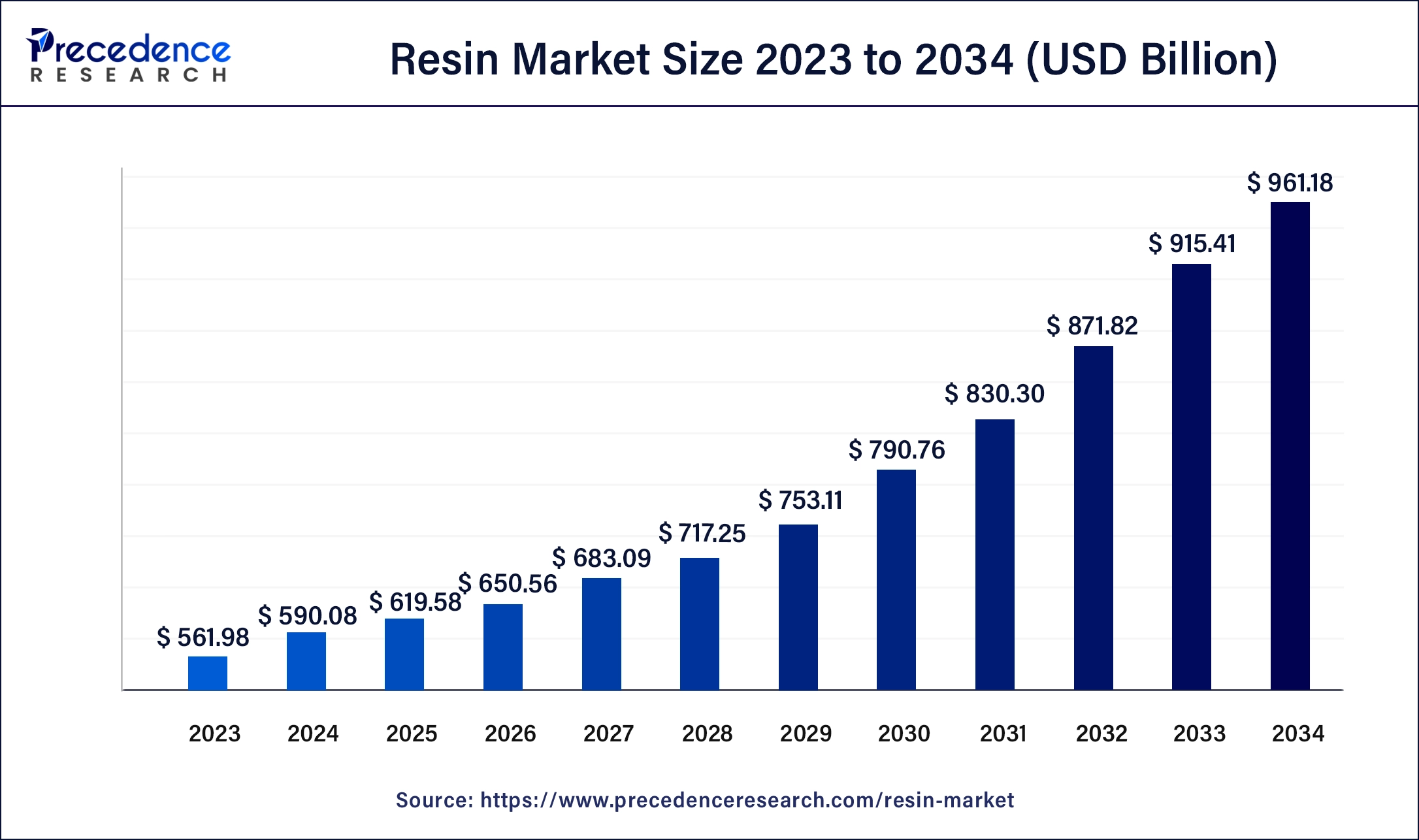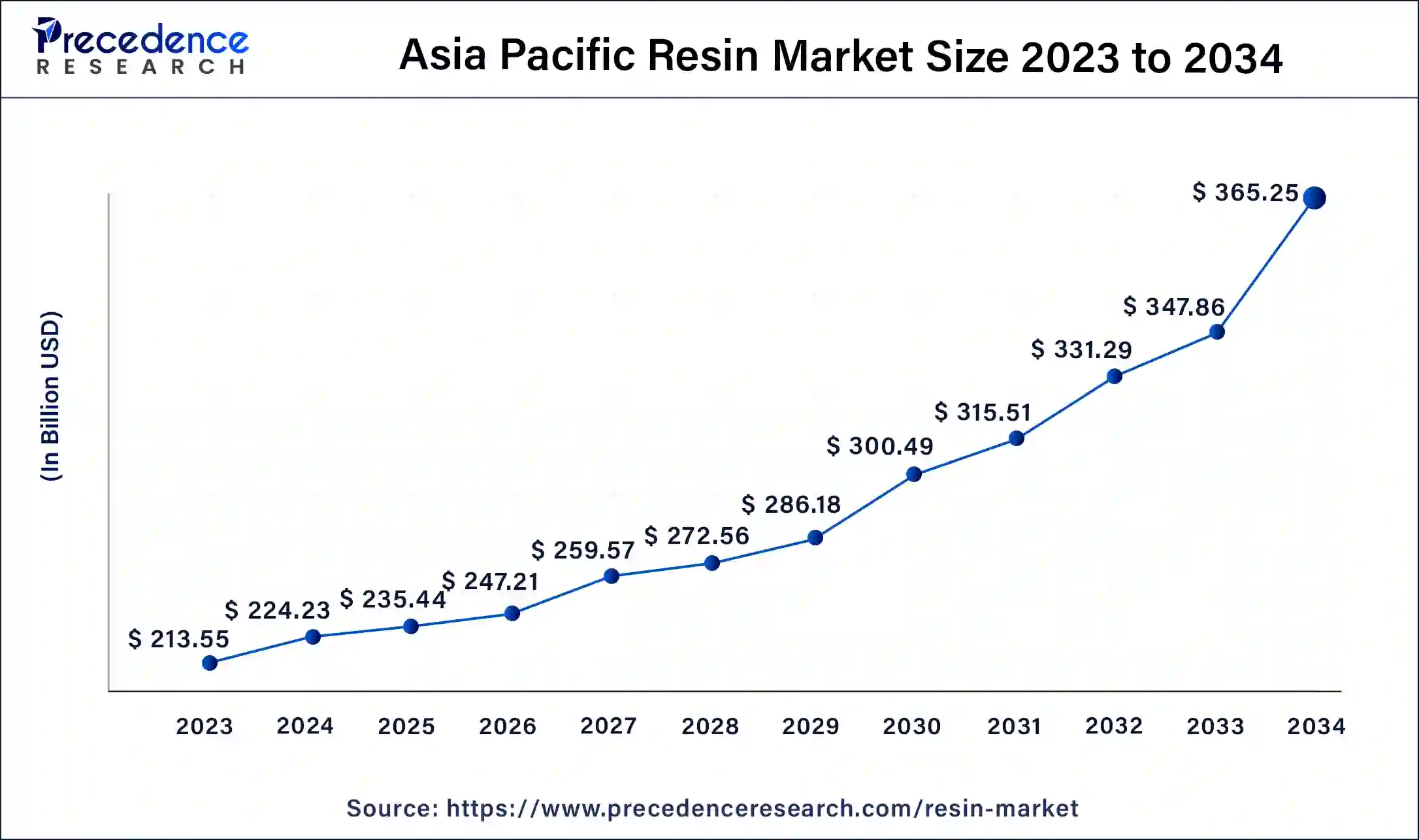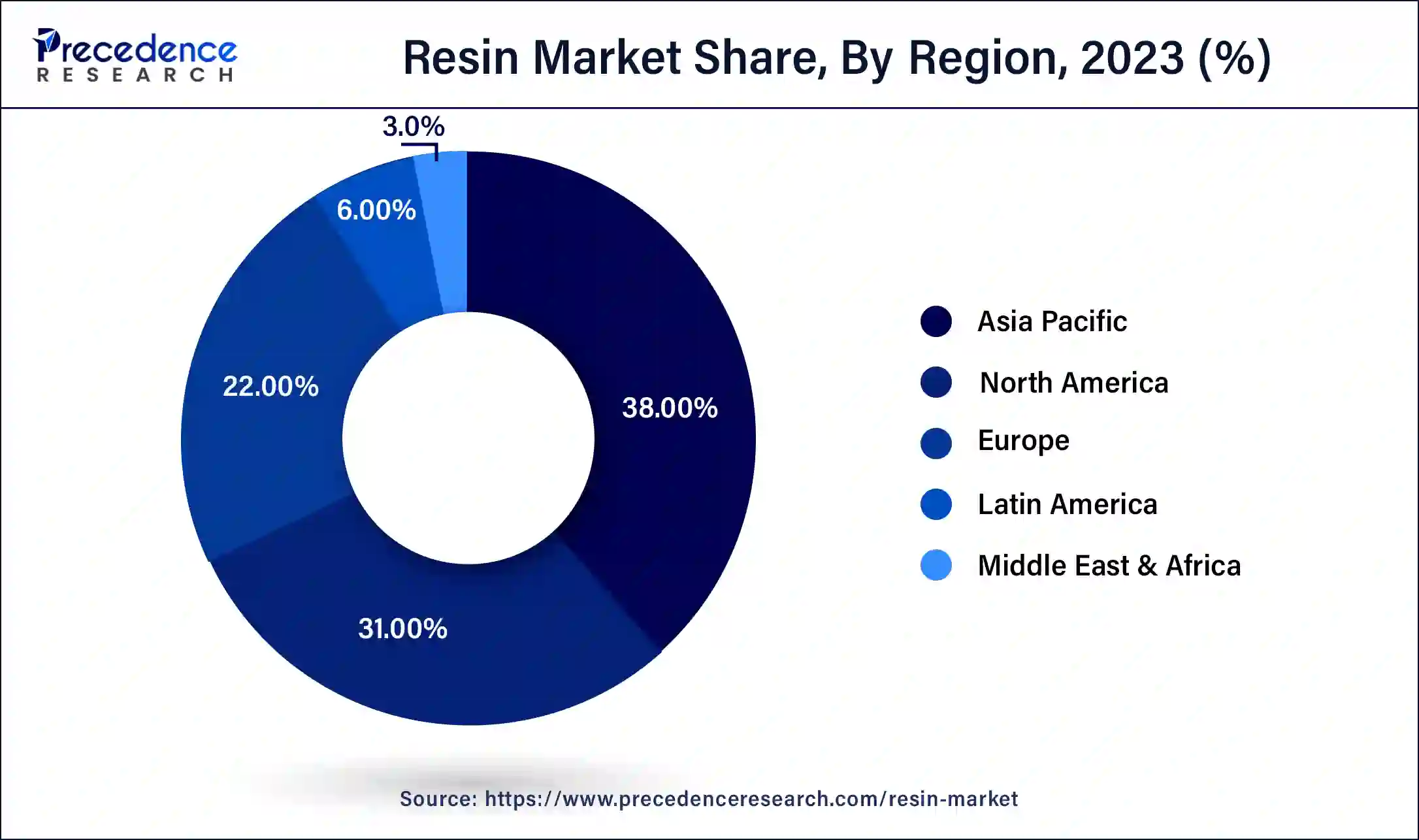May 2025
The global resin market size is calculated at USD 619.58 billion in 2025 and is projected to surpass around USD 961.18 billion by 2034, expanding at a CAGR of 5% from 2025 to 2034. The Asia Pacific resin market size accounted for USD 235.44 billion in 2025 and is expanding at a CAGR of 5.10% during the forecast period. The market sizing and forecasts are revenue-based (USD Million/Billion), with 2024 as the base year.
The global resin market size accounted at USD 590.08 billion in 2024 and is expected to be worth around USD 961.18 billion by 2034, at a CAGR of 5% from 2025 to 2034.

The Asia Pacific resin market size was estimated at USD 224.23 billion in 2024 and is predicted to be worth around USD 365.25 billion by 2034, at a CAGR of 5.10% from 2025 to 2034.

Asia-Pacific has held the largest revenue share of 38% in 2024. The packaging sector, including the production of plastic bottles, containers, and flexible packaging, was a major consumer of resins in the Asia-Pacific region. The demand for convenient and lightweight packaging materials continued to rise. Therefore, Asia-Pacific played a pivotal role in the global resin market due to its significant manufacturing capacity, diverse industries, and the presence of emerging economies.

North America is estimated to observe the fastest expansion. This is due to the growing emphasis on sustainable and environmentally friendly resins in North America, driven by increasing environmental awareness and regulatory measures. The development and adoption of biodegradable and recycled resins drive demand for the resin market across the region.
The market's growth in Europe is mainly due to its stringent environmental regulations. These regulations have a substantial impact on the resin market, encouraging the development and use of eco-friendly and sustainable resins. Moreover, the automotive and aerospace industries utilized resins for light weighting and performance enhancements. Resins were employed in various components, including interior materials and composites for aircraft. Thus, these factors further drive demand for the resin market across the region.
Resin can be derived from natural sources, such as plant exudates (e.g., tree sap), or they can be synthesized through chemical processes, as in the case of synthetic resins. Its properties may differ widely depending on their composition and intended use. Natural resins have been used for centuries in various applications, while synthetic resins have become increasingly vital in modern industry due to their versatility and controllable properties.
The resin market is a significant component of the global chemical and materials industry, and its growth and trends can be indicative of broader economic and technological developments. Resin is a broad and versatile class of natural or synthetic organic compounds that are typically solid or highly viscous substances, often with an amorphous or glassy appearance. Its ability to become harden & rigid and may exhibit a glossy or translucent surface when subjected to various chemical or physical processes and plays a crucial role in various manufacturing sectors, such as automotive, construction, packaging, and consumer goods.
| Report Coverage | Details |
| Growth Rate from 2025 to 2034 | CAGR of 5% |
| Market Size in 2024 | USD 590.08 Billion |
| Market Size in 2025 | USD 619.58 Billion |
| Market Size by 2034 | USD 961.18 Billion |
| Largest Market | Asia Pacific |
| Base Year | 2024 |
| Forecast Period | 2025 to 2034 |
| Segments Covered | By Type and By End-use Industry |
| Regions Covered | North America, Europe, Asia-Pacific, Latin America and Middle East & Africa |
Increasing use of plastics
Plastics have become ubiquitous in various industries due to their versatility, cost-effectiveness, and durability. This pervasive presence of plastics is intrinsically linked to the resin market because resins are the fundamental building blocks of plastic materials. Several sectors such as packaging and plastics provide durable, lightweight, and cost-efficient solutions.
The surge of e-commerce and the rising demand for efficient and sustainable packaging options have led to an increase in the use of plastic materials that has further drive demand for resins. Similarly, the automotive industry has observed a mounting reliance on plastics to decrease vehicle weight and increase fuel efficiency. The resins are used to manufacture numerous automotive components, comprising adhesives, lightweight composites, and coatings.
Moreover, construction and infrastructure projects operate resins for coatings, adhesives and sealants, this demand is closely tied to the construction industry's expansion driven by urbanization and infrastructure development. The increasing demand for resins in various industries or sectors will further drive demand for the resins market.
The versatility of resins in replying to the distinctive requirements of these various industries makes them a vital component in the growing demand for plastic-based products. As industries continue to seek cost-effective, lightweight, and environmentally sustainable solutions, the use of plastics and resins is expected to rise, further propelling the growth of the resin market.
Increasing environmental awareness
Environmental concerns, coupled with regulatory pressures, are shifting the focus towards sustainable and eco-friendly alternatives, which may disrupt traditional resin consumption patterns. Push for reduced plastic usage and the drive to mitigate plastic pollution is one of the primary factors restraining the demand for the resin market. Consumers are gradually seeking products and packaging that are recyclable, biodegradable, and less harmful to the environment. This shift in consumer behavior has driven various industries to discover substitutes to traditional resins, such as bio-based resins and compostable materials. Thus, the demand for conventional resins, particularly single-use plastics, may decline.
Furthermore, environmental regulations are also becoming more stringent. Governments and international bodies are imposing restrictions on the use of certain types of resins, particularly those that are non-recyclable or pose environmental risks. For instance, in March 2023, according to the environmental protection agency, eastman chemical resins Inc. will pay a penalty worth $2.4 million to resolve alleged environmental violations at its manufacturing facility. Manufacturers are under pressure to meet these regulations, which can necessitate costly reformulations of resin products and reduce their market appeal.
Moreover, recycling initiatives and the circular economy principles encourage the use of recycled resins, diverting demand away from new resin production. As recycling infrastructure improves and the quality of recycled resins increases, businesses are likely to favor these sustainable options. The resin market, in response, is evolving towards eco-friendly solutions.
Manufacturers are investing in research and development to create biodegradable and recycled resin alternatives, while also working on improving the recyclability of traditional resins. While these environmental constraints pose challenges, they also present opportunities for the resin market to innovate and adapt to meet the demands of a more environmentally conscious world.
Development and adoption of biodegradable and sustainable resins
The development and adoption of biodegradable and sustainable resins present a transformative opportunity for the resins market, driven by the growing global emphasis on environmental responsibility and sustainability. These innovative resins, often derived from renewable sources, offer several key advantages, making them a compelling choice for both businesses and consumers. Biodegradable and sustainable resins address the pressing issue of plastic pollution. With traditional plastics contributing to long-lasting environmental harm, these eco-friendly alternatives break down naturally over time, significantly reducing the burden on landfills and oceans.
The desire to mitigate such harm has fueled widespread interest and demand for these resins. Regulatory support further bolsters this opportunity. Governments and international organizations are introducing policies and regulations to limit the use of non-sustainable plastics. These regulations create a favorable environment for the development and adoption of biodegradable resins, as they align with the broader goal of environmental protection.
Consumer sentiment plays a pivotal role as well. The modern consumer is increasingly eco-conscious, actively seeking products and packaging that reflect their environmental values. Biodegradable and sustainable resins cater to this demand, offering a tangible way for companies to demonstrate their commitment to eco-friendly practices and win over environmentally conscious consumers. For instance, in August 2023, DIC Corporation launched environment-friendly waterborne polyurethane resins of HYDRAN GP series. These new resins decrease greenhouse gas emissions and unstable organic compounds (VOCs).
Moreover, the adoption of these resins is not limited to specific industries. They have applications in diverse sectors, from packaging and consumer goods to agriculture and healthcare. This versatility broadens the market's scope and potential, creating opportunities for resin manufacturers and suppliers to diversify their product offerings and target new customer segments. Thus, the development and adoption of biodegradable and sustainable resins represent a pivotal shift in the resins market, offering a pathway to ecological responsibility, regulatory compliance, and heightened consumer appeal. Companies that seize this opportunity can position themselves as leaders in a more sustainable and environmentally conscious future.
In 2024, the polyethylene segment had the highest market share of 41% on the basis of the type. Polyethylene is one of the most widely used plastics. It comes in various forms, such as HDPE (high-density polyethylene) and LDPE (low-density polyethylene), and is employed in applications like packaging, pipes, and plastic bags.
The polyethylene terephthalate (PET) segment is anticipated to expand at a CAGR of 8.3% over the projected period. This is due to PET being a versatile resin commonly used for the production of beverage bottles, food packaging, synthetic fibers, and various consumer goods. Its properties include transparency, lightweight, and excellent gas barrier properties.
In 2024, the packaging segment had the highest market share of 43% on the basis of the end-use industry. The packaging industry is a significant consumer of resins. Resins are used to manufacture a wide range of packaging materials, such as plastic bottles, containers, films, and closures, ensuring product protection, shelf life, and transportation efficiency.
The electrical & electronics segment is anticipated to expand fastest over the projected period at a CAGR of 8.2%. The electrical and electronics industry relies on resins for encapsulating and insulating electronic components, circuit boards, and connectors. Resins are essential for protecting electronics from moisture, heat, and other environmental factors.
By Type
By End-use Industry
By Geography
For inquiries regarding discounts, bulk purchases, or customization requests, please contact us at sales@precedenceresearch.com
No cookie-cutter, only authentic analysis – take the 1st step to become a Precedence Research client
May 2025
January 2025
February 2025
September 2024